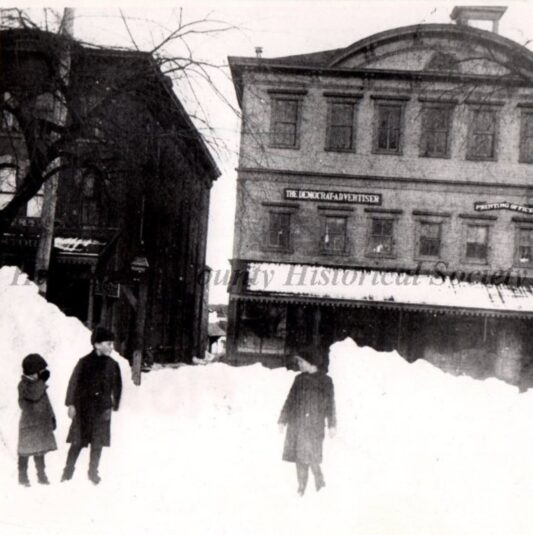Today I am returning to the buildings on the east side of Flemington’s Main Street that feature an arch along the front of their roofs, in particular, the two buildings constructed by John C. Hopewell, one on either side of the bank building that he put up in 1866 (See Flemington’s First Bank).
These two buildings were constructed in the mid 1870s and early 1880s and served as shelters for competing organizations. It makes me wonder about what sort of person John C. Hopewell was. He insisted his bank building be called Masonic Hall, but then put up a building next door with the label ‘Odd Fellows’ along the front. As far as I know, Hopewell himself was not a member of either organization.
Another tenant in that new building was the Democrat Advertiser, a newspaper that competed with the tenant of Hopewell’s building on the other side of the bank, the Hunterdon County Democrat. John C. Hopewell must have had something up his sleeve.
(In composing this article, I found I was coming across so many interesting people who had associations with each other that I needed a glossary to keep track of them all. You can find it added to the end of this article.)
Thanks to the people who have been generously sharing old photographs of downtown Flemington on Facebook, I have pictures of several of these arched-roofline buildings that are either no longer standing or have had the arches removed: Economy Hardware and the Oyster Restaurant have lost their arches. The Democrat building is still standing but unrecognizable. The Odd Fellows Hall is about to come down.
Fortunately, some of these buildings have been nicely preserved: the George Rea Building (the Clock Tower Building), the County Clerk’s Office, the Bartles-Fisher house at 149 Main St. and the house at 182 Main Street. The store at 129 Main Street still has its arch but needs a little TLC.
One of the buildings that is long gone is shown in this marvelous street scene of Flemington, on the right, across from the bank:
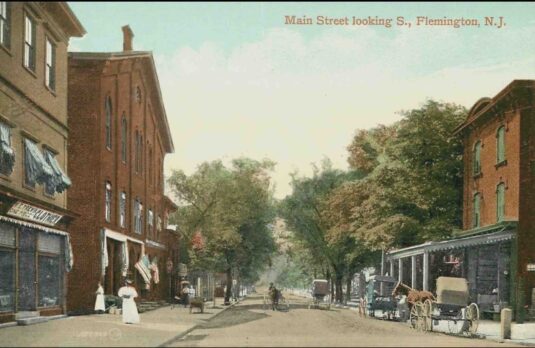
The Democrat’s Building
On November 4, 1875, the Hunterdon Republican reported that “John C. Hopewell has commenced the erection of a new brick building next to the Bank. It will be two stories high and will be occupied by Joseph V. Smith as a tobacco store and by the Hunterdon Democrat.”
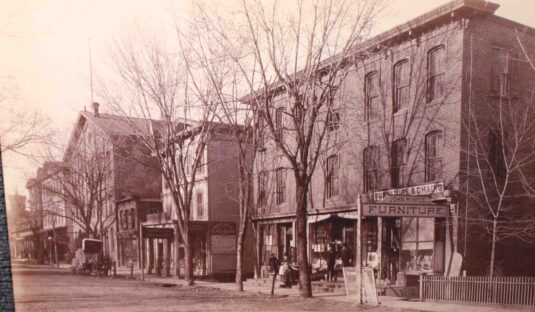
The new building was located at 104 Main St. Although it is hard to see, the photograph above shows the Democrat’s building to the right of the Hunterdon County Bank building (Hopewell’s ‘Masonic Hall’). Further to the right is a building with a peak on its roofline that is no longer standing.1
Regrettably, I cannot read the signs on the Democrat’s building, but this is most likely a 19th-century photograph. The large building on the right is today occupied by River Valley Realty (110 Main Street) and has lost its original façade. The property had been owned by John C. Hopewell, but in 1876 was sold to Joseph H. Higgins, and it is Higgins’ name that appears on the 1873 Beers Atlas (shown below).
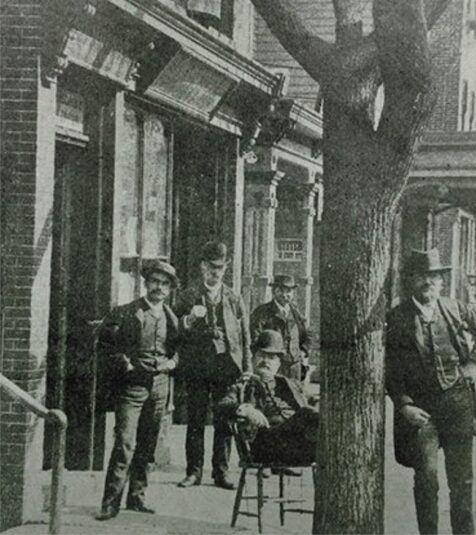 On February 2, 1876, John and Ann Hopewell sold the lot on which the new building stood to the new editor and owner of the Hunterdon County Democrat, Robert J. Killgore, for $6,000.2 The deed stipulated that the lot line was “two feet nine inches from the foundation wall of the Brick Building erected on sd Hopewell’s land in which The Hunterdon County Bank is located. . . It is expressly understood that the grantee will have use of the alley between the building on the lot hereby conveyed and the Brick Building; also, that the grantee will not erect a building on this lot taller than the building presently on sd lot.”
On February 2, 1876, John and Ann Hopewell sold the lot on which the new building stood to the new editor and owner of the Hunterdon County Democrat, Robert J. Killgore, for $6,000.2 The deed stipulated that the lot line was “two feet nine inches from the foundation wall of the Brick Building erected on sd Hopewell’s land in which The Hunterdon County Bank is located. . . It is expressly understood that the grantee will have use of the alley between the building on the lot hereby conveyed and the Brick Building; also, that the grantee will not erect a building on this lot taller than the building presently on sd lot.”
After the Democrat moved in, the building became a popular hang-out, as you can see from this great photograph (above).
An Early History of The Democrat
The Democrat had been in business since 1838. It’s first editor & publisher was George C. Seymour. In the 1840s, Seymour bought a lot from the Capner family on Main St., and in 1847 sold it back to Hugh Capner, with the provision that “the shop or printing office now occupied by Seymour on the above lot 1, which sd Seymour is to remove off said lot on or before April 1, 1847.” Two years later, he purchased a lot next to Charles Bartles from Peter I. and Cynthia Clark, 3 which can be seen on this detail from the 1851 Cornell Map.
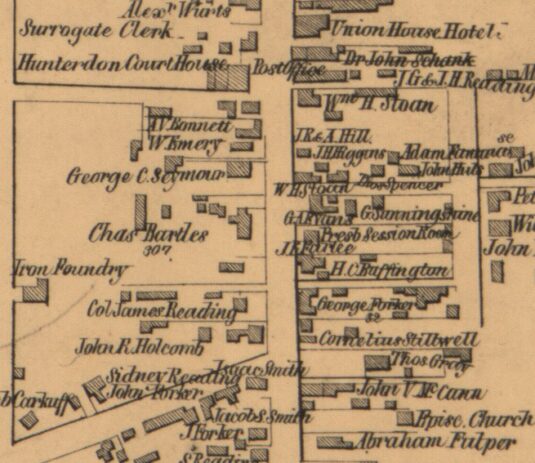
It was 1851 when Seymour sold the paper to Adam Bellis, who kept it going all through the Civil War. In 1866 Bellis sold it to Dr. Henry B. Nightingale of Delaware Township, whom the Hunterdon Republican described as “a well-known Democrat of the most ultra-kind.” Meanwhile, the Hunterdon Gazette was taken over in 1866 by former County Clerk Charles Tomlinson, who declared that he would be publishing “a first-class Democratic sheet, to be called The Democrat,” with J. Rutsen Schenck as editor of local news. It had been his intention to purchase the Democrat from Dr. Nightingale but was at first refused. Finally, as Hubert G. Schmidt wrote, in July 1867:
Both the Hunterdon Democrat and the Democrat disappeared from the scene overnight, and there appeared Volume I, Number 1, of the Hunterdon County Democrat. Tomlinson appeared as owner, Nightingale as chief editor, and J. Rutsen Schenck as editor of local news, presumably retaining Lewis Runkle as a reporter.
Tomlinson was in possession of his newspaper when the 1870 census was taken. At that time, he was identified as a 50-year-old editor with property worth $24,000. His wife Margaret, also 50, was living with him as well as his father-in-law, Aaron Barcroft, 92, retired farmer with property worth $4,000.4 On Dec. 26, 1872, the Hunterdon Republican reported that
“On 19 Dec. 1872, the store and dwelling of the late Albert Wyckoff, next to the County House, were sold to Charles Tomlinson and William J. Rockafellow for $6,790. Mr. Rockafellow will take the store for his business and Mr. Tomlinson intends converting a portion of the dwelling into an office for the Hunterdon Democrat newspaper.”
Whatever Tomlinson’s plans were for the Democrat, they were brutally interrupted in August 1875. On August 12, 1875, an obituary for Charles Tomlinson was published in the Democrat, stating that on August 5, 1875, Tomlinson had died while on a visit to New York City for treatment of his heart disease. He was only 56. His wife Margaret had died only three years previously and on Feb. 5, 1874, Tomlinson had married as his second wife Caroline Borden of Somerville. In November of 1875, the Republican noted that the Executors of Charles Tomlinson, dec’d had sold the house occupied by the office of the Democrat to David Van Fleet, Esq., for $4,002. Shortly afterwards, David Vanfleet sold the Democrat office to its new editor, Robert J. Killgore for $4300.5
Schmidt wrote that there was no evidence of a change in the Democrat’s ownership, except for an editorial in the edition published on Oct. 5, 1875, the first one by Robert J. Killgore.
Hopewell Hall
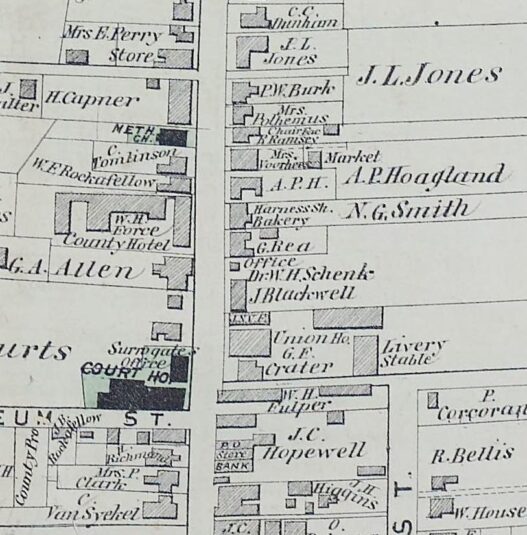 In my previous article on William H. Fulper’s store, I concluded that Fulper put up his renovated building with the arch along the front in 1880. This was five years after Hopewell constructed the small building used by the Democrat. And that was two years after the Beers Atlas of 1873 was published. As you can see from this detail of the Atlas, the lot owned by John C. Hopewell contained not only the bank building (which also housed a store and the post office), but two small buildings on either side, buildings that were later replaced.
In my previous article on William H. Fulper’s store, I concluded that Fulper put up his renovated building with the arch along the front in 1880. This was five years after Hopewell constructed the small building used by the Democrat. And that was two years after the Beers Atlas of 1873 was published. As you can see from this detail of the Atlas, the lot owned by John C. Hopewell contained not only the bank building (which also housed a store and the post office), but two small buildings on either side, buildings that were later replaced.
In 1882, Wm H. Fulper enlarged the alley between his store and Hopewell’s property, and paid $1200 for the stretch of 13/100ths of an acre.6 It is my suspicion that Fulper enlarged his store and Hopewell constructed his adjacent building at about the same time. The two look rather different, making me also suspect that Hopewell used a different builder from the one used by Fulper for his store. But both buildings were standing by 1883 when the Bailey map of Flemington was published. As you can see from this detail, Hopewell’s new Hall was numbered ‘13’ and located between Fulper’s store and the Masonic Hall.
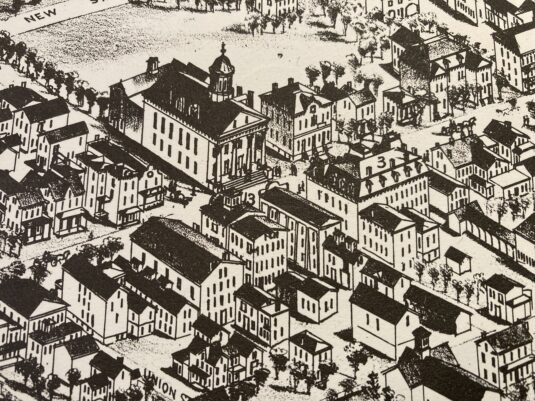
Hopewell’s Tenants
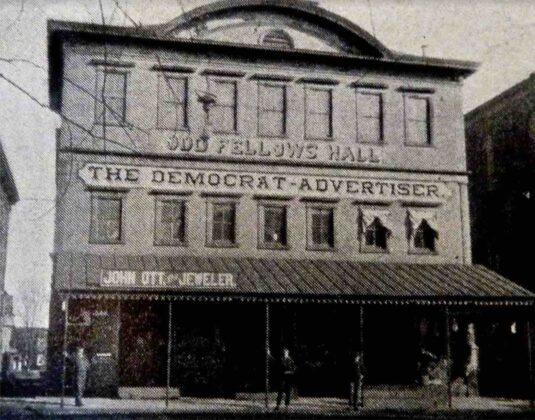
The photograph above shows that the major tenants of the Hopewell Building were The Democrat Advertiser, the jeweler John Ott, and the Odd Fellows. In fact, it seems that Hopewell preferred that the building be called Odd Fellows Hall, just as he insisted that the bank building next door be named Masonic Hall. But the Sanborn insurance people preferred to label it “Hopewell Building.”
One of the earliest Sanborn Insurance Maps available for Flemington was published in 1885. In the detail below, the “Hopewell Building” is shown between ‘Grocery D.G.’ (i.e., Fulper’s store) and ‘Masonic Hall’ (i.e., the bank building). The Hopewell Building contained a jeweler on the left and ‘D.G.’ [dry goods] on the right. “Printin” and “Lodge No.3” were up above. Behind the Hopewell Building there was a Horse Shed, a ‘Gasometer,’ ‘Ice Ho.’ [house], ‘Egg Store Ho.’ [house], etc.

One way I can tell that Hopewell’s building had probably gone up as early as 1882 is from a news story that appeared in the Hunterdon Republican on October 19th of that year:
On Tuesday morning, John S. Van Houten of Croton, in Raritan Tp., stopped his team on Court Street, alongside the Hardware store and left them untied while he went into the store. Almost as soon as he left, the horses started to run away down [toward] Main Street, knocking down a lamp post on the corner and went up against the jewelry store of Avery Parker, breaking a large show window. John Ott, who was working at his bench by the window, beat a hasty retreat when he saw them coming towards the window. The hind wheel of the wagon was torn off and one horse was somewhat cut about the head. A large crowd gathered and there was much excitement for a few minutes.
John Ott, Jeweler
John Jacob Ott (1851-1917), the jeweler, was born in Pennsylvania, but probably found work in Avery Parker’s Flemington jewelry store by the 1870s, although I did not succeed in finding Ott in the 1870 census. In 1880, however, he was boarding with the Kline family in Raritan Township, consisting of John Kline 50 carpenter, wife Sarah 32, and daughters Amanda 21 dressmaker, Annie 13, Jennie 11 and Louisa 8, as well as sons Harry 4 and George 1.
It was Amanda that John Ott married, on June 1, 1881. The wedding record identified them both as “of Flemington.” In 1887, the Republican’s editor reported on his visit to Parker’s store:
We visited the jewelry store of Avery Parker the other day and were impressed with the changed appearance. A new ceiling has been put in, new paper adorns the walls, and the store altogether presents a bright and cheerful appearance. Mr. Parker, as everybody knows, is one of the most reliable dealers in the State, hence his large trade. His gentlemanly assistant, John Ott, is always ready to accommodate customers and to him much of the popularity of the establishment is due.
When the famous Blizzard of ’88 hit Flemington, it left Main Street looking like this:
Then on Sept. 2, 1891, the Republican reported that:
John Ott purchased the jewelry store and business of the late Avery Parker, dec., of Flemington. Mr. Ott was employed by Mr. Parker for 17 years and is well known to all the patrons of the store. That he will continue the business with success is an assured fact.
Despite the good press he received in the Republican, Ott went bankrupt in the early 1900s and was obliged to move away from Flemington.
The Odd Fellows
The Independent Order of Odd Fellows, that is. This group was active in Hunterdon well before John C. Hopewell built them a meeting place in Flemington. I do not have access to a Hunterdon history of the Odd Fellows, but the Magnolia Lodge was meeting in Frenchtown as early as 1861. In 1867, “the members of Perseverance Lodge, No. 30 [Milford], Magnolia Lodge, No. 57 and Lackatong Lodge, No. 114 [Quakertown], I. O. O. F., convened in the Hall of Magnolia Lodge, in Frenchtown.”7
But it was not until 1875 that a Lodge was ‘instituted’ in Flemington. It was Lodge No. 94, “taking the place of Hunterdon Lodge, No. 94, which existed here some years ago,” as the Hunterdon Republican reported. The officers installed were Emanuel Tannewald, Henry A. Fluck, Henry S. Crater, George F. Crater (owner of the Union Hotel,) and John Ramsey. With George and Henry Crater involved, the Lodge must have been meeting in Crater’s (Union) Hotel at first.
It seems the men of Hunterdon took great pleasure in their private groups and often belonged to more than one. Another popular group was the Wickecheoke Tribe of Red Men, and one example is William Cronce who died from an accident at Croton in 1872. His short obituary mentioned that he was a member of both the Odd Fellows and the Red Men.
The term ‘lodge’ seems to have referred to different men’s social organization. That was the word used by the Republican when it reported that there were nine of them in Hunterdon County in 1880, and included among those nine was the Darcy Lodge, No. 27 of the Free and Accepted Masons of Flemington, who held their annual election that December. Both the Masons and the Odd Fellows had a multitude of positions one could be elected to. The news editors seem to have assumed that everyone knew what the abbreviations they used stood for, but I did not until I looked them up in Wikipedia.
In 1883, the Masons elected W. M. (Worshipful Master) William E. Trewin, S. W. (Senior Warden) John J. Warne, W. (Warden) Amos Thatcher, S. D. (Senior Deacon) John S. Williamson, J. D. (Junior Deacon) Austin G. Nevius, and M. of C. (Masters of Ceremony) John H. Stockton & Eli C. Cook. Also elected were Treasurer George T. Gray, Secretary John H. Demott, and Chaplain Andrew T. Connet. Stewards were Samuel Cooley & Elisha S. Wyckoff. They were ‘installed’ by William G. Callis, a Past Master.
The Odd Fellows also held an election, with a similar assortment of officers. (I had a little more difficulty identifying them.) The Oddfellows had four lodge degrees: three higher encampment degrees, and one Patriarchs Militant degree.
But then there were also these mysterious positions (perhaps they’ve changed since 1883): C.P., H.P., S.W., J.W., G., O.S., I.S., 1st W., 2nd W., 3rd W., 4th W. and G. of T. (C. P.: Howard Sutphin; H. P.: Frederick Bartleman; S. W.: Joseph V. Smith; J. W.: Thomas B. J. Burd; G.: Charles A. Higgins; O. S.: Samuel P. Kinney; I. S.: Charles D. Fulper; 1st W.: Henry A. Fluck; 2nd W.: John H. Demott; 3rd W.: Franklin C. Burk; 4th W. John H. Stockton; G. of T.: George W. Fulper and George Webster, Jr.) Other positions were more obvious: Scribe: Forrest A. Rice and Treasurer: John E. Carkhuff. You may notice that Joseph V. Smith, the tobacco merchant whose store was on the other side of the bank in the Democrat’s building, was a member of the Odd Fellows.
This election took place at a meeting held on February 14, 1883, at which an “encampment” was established, named the Adelphia Encampment, No.19. (Note: Many of the Hunterdon Lodges sent notices to the Hunterdon Republican, but the Flemington Lodge was strangely silent.) This is probably the Lodge that was established to meet in the new Hall built by John C. Hopewell around 1881, although the Hunterdon Republican said nothing about that.
Although some Lodges purchased properties for their halls, I found no evidence that the Flemington Lodge did so; they remained tenants. For how long is hard to say.
One of the most prominent members of the Flemington Lodge was Howard Sutphin (1850-1927), who was regularly appointed to high positions in the organization from the time he was in his 20s, including Grand Master of the entire state of New Jersey in 1890. He began his career as a merchant by clerking in the store of none other than William H. Fulper, located next door to the Odd Fellows’ Hall on Main Street.
The Democrat Advertiser
The other prominent tenant in John C. Hopewell’s new building was the Democrat-Advertiser, which began publication in Flemington in 1881. Hubert G. Schmidt, in his marvelous pamphlet, “The Press in Hunterdon County,” noted that the Democrat Advertiser was one of four papers being published in Flemington in 1890.8 That was when the NJ Legislative Manual published a list of newspapers in the state. The Flemington papers and their editors were Hunterdon County Democrat, Robert J. Killgore, editor and publisher; Democrat-Advertiser, John N. Jones and John N. Voorhees, editors and publishers; Hunterdon Republican, William G. Callis, ed. (the Master of the Masonic Hall); and the Home Visitor. Mr. Schmidt wrote:
The reader may well ask how Flemington could support four newspapers. Apparently, it did not support them all well, for the Home Visitor failed in November 1899. The editor for the past five years, William V. Ramsey, had been a good newspaper man, and many a reader was sorry to see his paper disappear from the scene. The Hunterdon Democrat bought his outfit and subscription list at a sufficient price for him to settle with all creditors without loss to anyone. But it was a narrow squeak.
Here is how Schmidt described the origins of the Democrat Advertiser:
George C. Hughes started the Hunterdon Advertiser in May 1881, and in 1883 sold out to a lawyer named John Newton Voorhees and a partner named John L. Jones. Voorhees and Jones, as spokesmen for the anti-Killgore wing of the Democratic party, changed the name to the Democrat Advertiser. Later, Voorhees bought out Jones’ interest and took his son as a partner. It was this son, H. Martin Voorhees, now sole owner, who gave [Lewis] Runkle, previously editor of the Democrat, a job as local editor.
I have a bit of a disagreement with Mr. Schmidt regarding Voorhees and Jones, but first a word about Mr. Hughes:
George Crater Hughes
On June 16, 1881, the Hunterdon Republican reported that “The Hunterdon Advertiser is the latest addition to the literature of our county. It is published by George C. Hughes, in Flemington and was issued for the first time on Friday, 10 June 1881.”
George C. Hughes (1862-1938) was the son of Arthur Hughes and Susan Stires of Flemington. Arthur Hughes worked as a wheelwright, so it is hard to say where George got his newspaper ideas. But in the 1880 census, when George was still living at home and only 17 years old, he was listed as a printer. A year after starting up his own paper, in 1881, he married Ella R. Rittenhouse (1862-1937), daughter of Dewitt C. Rittenhouse and Jane Aller Shepherd, also of Flemington. Dewitt was working as a constable in 1880 and daughter Ella was still at home.
The Advertiser was “an eight-page paper selling for $1.00 a year. After Hughes sold his paper in 1883, he and wife Ella moved to Stroudsburg, Pa where the couple had eight children and spent most of the rest of their lives.
Voorhees & Jones
Schmidt wrote that George C. Hughes sold out to the partners John N. Voorhees and John L. Jones in 1883. The Jones family saw it differently. The obituary for John L. Jones, published in the Advertiser of March 17, 1904, claimed that “He [Jones] established THE DEMOCRAT-ADVERTISER in 1882 and conducted it as editor and proprietor till 1887” when he took Voorhees on as partner.
Clearly, I need to visit the Historical Society to get a look at the Advertiser of 1883. Whenever that happens, I will make additions to this article. Unfortunately, because I am relying on mentions in the Hunterdon Republican, I have found no helpful information about Voorhees’ connection with the Democrat Advertiser. (No luck searching for copies on Newspapers.com either.)
As was related in the Jones obituary, the partnership of Jones and Voorhees lasted to 1891, when Jones sold his interest to John N. Voorhees. But the obituary neglected to mention that the reason Judge Jones got out of the newspaper business was that he had been caught embezzling funds from the Flemington National Bank, of which he had been president. But that is a story for another time.
John Lambert Jones, Esq.
John L. Jones (1822-1904), son of Asa Jones and Elizabeth Servis, was born in Headquarters, Delaware Township and spent his childhood in Flemington while his father served as Hunterdon County Sheriff. Kingwood historian John W. Lequear, who wrote “A Visit To Flemington” about his visit there as a child in 1834, mentioned Jones:
Asa Jones was then High Sheriff [1833-1836] and while our father was transacting his business matters, my brother and I sauntered out to the stable, back of the County buildings, where we met with the Sheriff’s son, John L. Jones, and his pleasant social disposition soon enabled us to lay the foundation of an acquaintance that has continued to this day.
On Jan. 24, 1850, John L. Jones married Catharine Stover (1824-1909), daughter of Henry S. and Mary Anna Stover of Bucks County, PA. The couple had three sons from 1851 to c.1854, the second of whom died age three in 1856. The other two (Asa and John Jr.) became lawyers like their father.
And like his father, John L. Jones, Sr. served as County Sheriff, from 1862 to 1865, and as Deputy Sheriff 1865-66. He served in various public positions, including Judge of the Court of Common Pleas (1878-1883), and spent most of his life as a merchant and resident of Flemington. He was also an investor in real estate and was buying up Flemington properties from 1850 on.
In 1890 he was elected to the NJ Editorial Association, but the next year, his financial misdeeds came to light, and he was obliged to resign from the Advertiser and sell his interest to his partner John N. Voorhees.
John N. Voorhees, Esq.
John Newton Voorhees (1835-1897), son of Judge Peter E. Voorhees and Rebecca Wyckoff of Readington Twp., married on Dec. 8, 1857, Ellen Ann Large (1839-1863), daughter of John Knowles Large and Eliza Ann Hall, also of Readington.
By 1858 he had gained a reputation as an excellent orator. On June 30, 1858, the Hunterdon Gazette announced that he would be delivering the 4th of July Oration at Locktown. “Mr. Voorhees is an interesting public speaker and will undoubtedly do justice to the occasion.” When Egbert T. Bush wrote his article on the Stockton Hotel register, he mentioned that Voorhees would be speaking there in January 1876 and added this comment: “Newt Voorhees is remembered by the old and not so old, as the flowery orator of the Hunterdon County Bar.”
Voorhees’ wife Ellen died tragically at the age of 23 years 9 months 27 days, on August 10, 1863, and was buried in the Rural Hill Cemetery at Whitehouse. Much to my surprise, I could not find an obituary for her that would explain what caused her death. She had had two children, Anna Rebecca (1859 – ?) and Henry Martin Voorhees (1861-1913). As often happened with these 19th-century families, where the mortality of young mothers was so high, her sister Hannah Mary Large (1842-1925) stepped in to marry the widower and raise his children. The couple married on Sept. 26, 1865, at Whitehouse, but did not have any additional children.
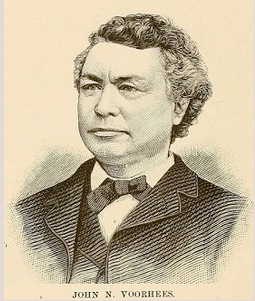
At the end of 1871, Edward R. Bullock resigned as Prosecutor of Pleas for Hunterdon County, and the governor named Voorhees to take his place. Unlike John L. Jones, John N. Voorhees kept his extra-legal affairs out of the newspapers for the most part. All during the 1880s, the only mention of Voorhees in the Hunterdon Republican was in relation to his law business, which was an active one.
Even though the Advertiser claimed to cater to merchants needing a space to advertise, the not-so hidden purpose was political. The Civil War was over, and harmony was supposed to prevail, but political rivalry was alive and well in Hunterdon County. The Democratic Party, which was dominant in Hunterdon all through the middle of the 19th century, was itself divided. (Sound familiar?)
As Schmidt wrote, when Voorhees and Jones partnered up, whenever that was, they changed the name of the paper from Hunterdon Advertiser to Democrat Advertiser, to indicate their interest in Democratic party politics, and also to suggest that information provided by the editor of the Hunterdon County Democrat (see below) was not to their liking.
For about twenty years, the paper did well, until Jones got into financial trouble in 1891, retired from the paper, and sold out his interest to partner John N. Voorhees. Shortly afterwards, John L. Jones’ son Asa Jones retired as local editor, and was succeeded by William A. Abbott, who had been the office foreman for several years.
John N. Voorhees died on January 9, 1897, from diabetes. He was almost 62 years old and was survived by second wife Hannah M. Large. The Hunterdon Republican published an obituary for him on Jan. 13, 1897, describing his history of partnerships as an attorney, but said nothing about his connection with the Democrat Advertiser.
This is somewhat surprising inasmuch as his son, Henry Martin Voorhees, who had also taken up the legal profession, not only practiced law with his father but took over management of the newspaper, while William A. Abbott moved on to manage the Morris County Journal, published at Dover. However, that did not last long. By April 1899, Abbott was “restored to his old position as foreman of the Democrat Advertiser,” while H. M. Voorhees continued as editor and “proprietor,” as reported in the Hunterdon Republican.
Meanwhile, John L. Jones was obliged to spend some time in court settling his affairs. The sheriff seized his property and offered it at public sale where it was purchased by the Flemington National Bank. The Beers Atlas shows Jones owning several properties in Flemington. The one he called home was located across from the Capner lot, a part of what was known as Blackwell’s row, at the corner of Main and Bloomfield. Apparently allowed Jones and his family to continue living there. But it was only fitting that in 1897 that property was demolished to make room for a new building for the Flemington National Bank. (See Oysters Every Style for a brief history of the bank.)
Unlike John N. Voorhees, who despite his oratorical skills, seems to have been a fairly modest fellow, John L. Jones got a long & fulsome obituary in the Democrat Advertiser, compliments of local historian Jonathan M. Hoppock, following his death on March 9, 1904, age 81. Apparently, he had a winning personality. As Hoppock wrote: “His circle of friends embraced many of the most prominent people of the State, and in public movements his judgment was generally sought.” It is a little ironic, then, that Snell’s History of Hunterdon County included a portrait of Voorhees but had nothing for Jones.
The Democrat and the Advertiser
During his later years, Robert J. Killgore had handed over his editorial duties to his son Anthony, and it is Hubert G. Schmidt’s suspicion that he and local editor Lewis R. Runkle did not see eye-to-eye. This may be why Runkle left the Democrat in late March 1897 and took on the same position at the Democrat Advertiser. Schmidt wrote:
When he [Runkle] left the Democrat on March 30, 1897, he told his reading public that it was voluntarily. The “general depression in all branches of business,” about which Runkle had written, and which caused the Democrat to lower its subscription rate to $1.50 a year, may have had something to do with his leaving. In any case the editor for both general and local news became Anthony Killgore, son and heir of Robert J. Killgore.
From then on, Runkle and Killgore maintained a long-running, and often not very polite, dialogue as they shared their political differences with the public. Schmidt called it “a friendly feud.”
Whether there was resentment between Lewis Runkle and Anthony Killgore can only be guessed, for both tried to be gentlemen, even when quarreling as to facts or as to how facts should be interpreted. In 1901, four years after Runkle’s leaving the Democrat, Killgore wrote of “the easy way that our friend Runkle of the ‘Advertiser’ has learned of late years to jump from one position to another on almost any question he takes up.” . . . Runkle, for his part, did not often lose his temper. During his fifteen years with the Democrat-Advertiser, he was the same mellow, usually witty, gentleman he had been during his forty years on the Democrat staff.
The Killgore-Runkle competition lasted right up until Lewis Runkle’s retirement in 1912, following one last column in which he stated that he was not opposed to everything; he listed the things he was “for” as:
good lights, sanitation, school ma’ams, descriptive slang. sawing wood, gardening, moderate exercise, good food, his wife, the careful cleaning of cellars, and the setting out of a tree each Arbor Day.
Lewis R. Runkle died two years later on November 25, 1914, age 74. Anthony Killgore gave his old rival a “fulsome obituary.” But then, eight years later, on January 22, 1922, Killgore himself died suddenly, at the age of 65. As a consequence, the paper was put up for sale and purchased by Alex L. Moreau of the Freehold Transcript of Monmouth County and handed over to Moreau’s nephew D. Howard Moreau. Meanwhile, the Advertiser changed hands several times until finally in 1926, it was absorbed into the Democrat. By that time, both papers had left their old locations in Hopewell’s buildings.
A Flemington Glossary
Abbott, William A. (1862-1938) born in Lambertville to Wesley W. Abbott & Maria Reilly, began work as a printer at the Lambertville Record in 1878, and joined the Democrat Advertiser in Flemington in 1883. In 1897, he and a friend traveled to Alaska, and when he returned, he took up work as foreman at the Morris County Journal. In 1899, he rejoined the Democrat Advertiser, but in 1910, he purchased the Hunterdon Republican. Shortly afterward, he married his wife Fanny Bryant, who was born in Colorado, at the age of 50. Abbot remained at the Republican right up to the day before his death. After publishing one last edition of the paper, he went to St. Francis Hospital, Trenton, and died there on July 28, 1938. His wife Fanny, who was 38 when she married Abbott, survived him until the age of 82, dying on Oct. 18, 1956. The couple is buried in Flemington’s Prospect Hill Cemetery.
Dunham, Clarkson C. (1831-1891), s/o Geo. W. Dunham and Phoebe Vail, married 1854 Jane Elvira Jones (1833-1886), d/o Shf Asa Jones & 2nd wife Susan McIntyre, and sister of John L. Jones, Esq. Their daughter, Louise Elvira Dunham (1857-1912), married Anthony Killgore. According to his obituary in the Hunterdon Republican, he was cashier of the Flemington National Bank. When he came to Flemington, as a young man, he was a clerk in the store of William P. Emery, who died 1889, then worked in the mercantile business for brother-in-law John L. Jones and then as Teller of the Hunterdon Co. National Bank. When Charles Tomlinson, who died in 1890, resigned the position of Cashier, Mr. Dunham was promoted to that position and remained with this bank until formation of the Flemington National Bank, in 1876, when he became Cashier for this bank.
Fulper, William Hill (1840-1887), s/o Abraham Fulper, potter, and Jane Forker; married 1867 Mary Ann Higgins, d/o Judiah Higgins and Charity Fisher. Owner of the store located next door to Hopewell’s building, the one housing the Democrat-Advertiser and the Odd Fellows. (See Fulper’s Store)
Hopewell, John C. (1814-1888), s/o of Becket Hopewell & Rebecca Porter of Mount Holly, NJ, married 1835 Ann Housel (c.1814-1885), had 7 children. Built the Hunterdon Natl Bank building (Masonic Hall), the Odd Fellows Hall and the building used by the Hunterdon Co. Democrat; organized the Flemington Gas Co. and the Flemington Water Works. (See One Man Makes A Difference)
Hughes, George Crater (1862-1938), s/o Arthur Hughes & Susan Stires of Flemington, married 1882 Ella R. Rittenhouse, d/o Dewitt C. Rittenhouse and Jane Aller Shepherd. After quitting the newspaper, he and family moved to Stroudsburg, Monroe Co., Pennsylvania. As far as I can see, he was not directly related to George F. Crater (1820-1879), proprietor of the Union Hotel.
Jones, Asa (1782-1874) Sheriff of Hunterdon Co. 1833-36; innkeeper & owner of the County Hotel; Flemington Postmaster 1866-68 (despite his strong support for the Confederacy); owner of a great many properties. Married first (1817) Elizabeth Servis (c.1798-1830), mother of Catharine Servis Jones and John Lambert Jones. Married second Susan McIntyre, mother of Jane Elvira Jones (wife of Clarkson C. Dunham) and four others.
Jones, Catharine S. (1819-1889), d/o Shf Asa Jones & Elizabeth Servis, married first Joseph Besson (1800-1849), Raritan Twp. Clerk, no children; married second William H. Williamson (1818-1882).
Jones, John Lambert, Esq. (1822-1904), s/o Asa Jones & Elizabeth Servis, brother of Catharine S. Jones Besson, married 1850 Catharine Stover (1824-1909). Had three children, one of whom died age three. Served in many civic positions, including president of the Flemington National Bank (1877-1891). Partner with John Voorhees as publisher of the Democrat Advertiser.
Killgore, Anthony (1856-1922), s/o Robt J. Killgore & Alice Vansyckel, married 1877 Louisa Elvira Dunham (1857-1912) d/o Clarkson C. Dunham & Jane Elvira Jones. Took over editorship of the Democrat in the 1890s from his father and became official editor after his father’s death in 1898.
Killgore, Robert J. (1820-1898), married 1843 Alice Vansyckel (1822-1875), d/o Aaron Vansyckle, Jr. and Mary Bird; acquired a farm near Pattenburg in Bethlehem Twp. He was elected County Surrogate in 1869 and served until November 1874. From 1875 he was active in the newspaper business, taking over the Democrat that year. As Schmidt wrote, “he had practically dominated Hunterdon County journalism for at least a quarter of a century.” In his later years, he handed over the job of editor to his son Anthony Killgore.
Sutphin, Howard (1850-1927), s/o John J. Sutphin & Mary Wilson, married __ Elizabeth Groff; had daughters MayBelle who married John B. Ramsey, Jr. and Annie Abel who married Walter N. Kuhl. He was Grand Master of the NJ Odd Fellows, among many other positions. Was a very successful Flemington merchant, beginning his career by clerking in the store of Wm Fulper in 1870.
Tomlinson, Charles (1819-1875), s/o Francis Tomlinson and Maria Larison, married first, 1843, Margaret Barcroft (1818-1872), d/o Aaron Barcroft, Esq. and Margaret Opdycke; married second, 1874, Caroline Borden of Somerset. Served as County Clerk in 1854-59 as a member of the Whig party but soon became an ardent Democrat. Served as cashier of the Hunterdon Co. National Bank during the Civil War. Bought out the Hunterdon Gazette in 1866 and combined it with the Hunterdon Democrat. His lot on Main Street was sold by his executors in 1876 to David Vanfleet, who then sold it to the newspaper editor, Robert J. Killgore.
Voorhees, John Newton, Esq. (1835-1897), s/o Judge Peter Emery Voorhees & Rebecca Wyckoff, married 1857 Ellen Ann Large (1839-1863) and in 1865, Hannah Mary Large (1842-1925), daughters of John Knowles Large & Eliza Ann Hall.
Egbert T. Bush: Voorhees was “remembered by the old and not so old, as the flowery orator of the Hunterdon County Bar.” He established the Democrat-Advertiser in partnership with John L. Jones in 1881.
Footnotes:
- The photograph was shared with me by Chris Pickell, from the Hunterdon Co. Historical Society collection. ↩
- H.C. Deed Book 162 p.430. ↩
- H.C. Deeds Book 87 p.215, Book 94 p.109. ↩
- Barcroft died a few months later, Nov. 3, 1870, and was buried in the Rosemont Cemetery. Also in the household was Louisa Poulson 19 domestic servant and Randle Carpenter 16 apprentice to printer. ↩
- H.C. Deed Book 163 p.165. ↩
- H.C. Deed Book 196 p.47. ↩
- Hunterdon Republican, May 10, 1867. ↩
- Schmidt, p.50. ↩
- Schmidt mistakenly wrote the partnership was with William T. Bird, but there was no such person. John T. Bird was identified in Voorhees’ obituary in the Hunterdon Republican, published Jan. 13, 1897. ↩
- H.C. Deed Book 145 p. 381. Another lot in Flemington was also included in the sale. See The Fisher-Reading Mansion for an early history of the house; Mr. Voorhees was not mentioned in that article. ↩
